IFRS 18 Presentation and Disclosure in Financial Statements: summary
IFRS 18 was issued in 2024 and is mandatorily applicable for the period starting on or after 1 January 2027, with earlier application permitted.
However, please watch out because we need to apply IFRS 18 retrospectively, with the restatement of the comparative period.
It means that if you apply IFRS 18 from 2027, also the numbers for 2026 must be presented in line with the new rules.
IFRS 18 replaces the oldest standard IAS 1 Presentation of Financial Statements which will no longer applicable.
This summary splits the topics covered in IFRS 18 to the following subtopics:
- Introduction: Objective, scope, definitions, separating and aggregation;
- General requirements for financial statements;
- Profit or loss statement – main changes here!;
- Statement of other comprehensive income
- Statement of financial position
- Statement of changes in equity
- Notes
- Final word and video with summary.
1. Introduction to IFRS 18 Presentation and Disclosure in Financial Statements
1.1 Objective of IFRS 18
IFRS 18 establishes the requirements for the presentation and disclosure of the information in the general purpose financial statements.
The objective is to make sure that entities provide relevant information faithfully representing insurance contracts. (see IFRS 17.1)
1.2 How to apply IFRS 18
We need to apply IFRS 18 retrospectively, with the restatement of the comparative period.
It means that if you apply IFRS 18 from 2027, also the numbers for 2026 must be presented in line with the new rules.
2. General requirements for financial statements
2.1 Objective of financial statements
The objective of financial statements is to provide financial information about a reporting entity’s:
- assets;
- liabilities;
- equity;
- income; and
- expenses,
so that the users of financial statements can assess the prospects for future net cash inflows the entity and management’s stewardship of the entity’s economic resources. (IFRS 18.9)
2.2 A complete set of financial statements
The components of the complete set of financial statements are (IFRS 18.10):
- a statement(s) of financial performance for the reporting period;
- a statement of financial position as at the end of the reporting period;
- a statement of changes in equity for the reporting period;
- a statement of cash flows for the reporting period; and
- notes for the reporting period;
- comparative information for the preceding period;
- a statement of financial position as at the beginning of the preceding period if required (i.e. when applying the new accounting policy retrospectively or makes material restatement retrospectively).
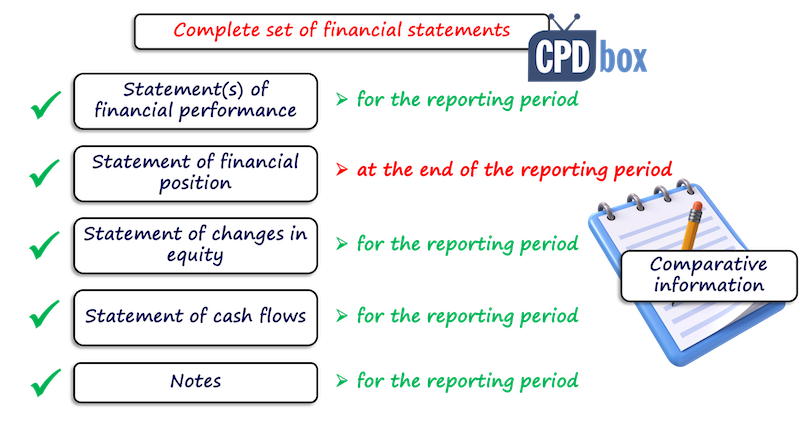
As for presenting the statement of financial performance, there are two options to present it as:
- a single statement of profit or loss and other comprehensive income, in two sections; or
- two separate statements.
2.3 Identification of financial statements
All the financial statements must be clearly identified, with the following information to disclose:
- the name of the reporting entity, and any change from the preceding reporting period;
- information about group or separate financial statements;
- date of the end of the reporting period or the period covered;
- presentation currency;
- level of rounding used.
IFRS 18 then sets the main principles, such as:
- Frequency of reporting;
- Consistency, disclosure and classification;
- Comparative information;
- Aggregation, disaggregation and offsetting
3. Profit or loss statement
IFRS 18 brings significant changes and specifications to the presentation of profit or loss, especially by introducing categories of income and expenses, and new subtotals to be presented.
3.1 Categories in the statement of profit or loss
All income and expenses in the statement of profit or loss shall be classified into one of the five categories:
- Operating category – this is a default category and here, all items not included elsewhere are classified.
- Investing category – for example, returns on investments, rentals from investment property, etc.
- Financing category – all income and expenses related to liabilities, either from raising finance (e.g. interest expense on bonds, loans) or from other liabilities (e.g. unwinding the discount on long-term provisions).
- Income taxes
- Discontinued operations
These categories are NOT the same as categories in the statement of cash flows under IAS 7, although they may remind them.
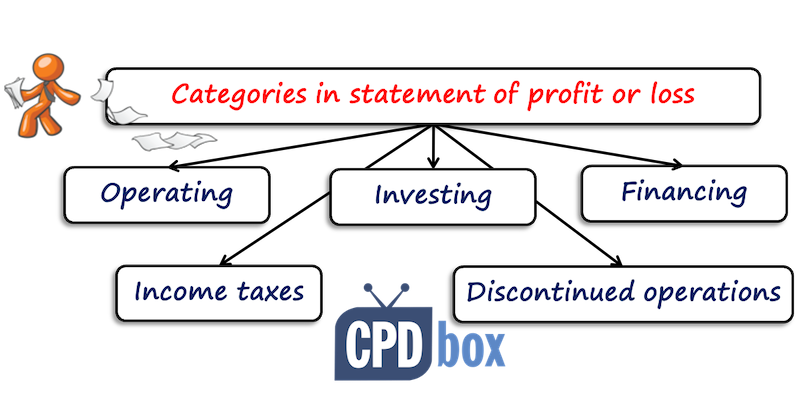
Also, when an entity has specified main business activity, then it classifies certain items differently than other entities:
- If specified main business activity is investing in assets, then those expenses and income related to investing in assets belong to operating category (not investing);
- If specified main business activity is providing finance to customers, then those expenses and income related to providing finance to customers belong to operating category (not financing).
3.2 Totals and subtotals in statement of profit or loss
The mandatory subtotals are also a new requirement in IFRS 18 as compared to IAS 1.
Many entities presented those subtotals anyway, IFRS 18 just specifies how they should be determined.
There are three new mandatory subtotals:
- operating profit or loss – including all income and expenses in operating category;
- profit or loss before financing and income taxes – including operating profit or loss and all income and expenses in investing category;
- profit or loss, including all items in profit or loss.
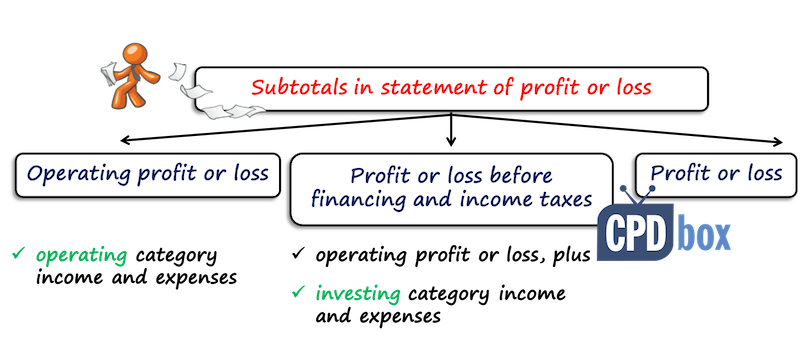
3.3 Line items to be presented in profit or loss
As a minimum, an entity shall present the following amounts:
- Amounts required by IFRS 18:
- Revenue, with presenting interest revenue and insurance revenue separately;
- Operating expenses (by nature or by function);
- Share of the profit or loss of associates and joint ventures by equity method;
- Income tax expense or income;
- Total for discontinued operations under IFRS 5.
- Amounts required by IFRS 9 Financial Instruments;
- Amounts required by IFRS 17 Insurance Contracts.
On top of these line items, an entity should present profit or loss for the period in allocation:
- attributable to non-controlling interests and
- attributable to owners of the parent.
4. Statement presenting comprehensive income
In the statement presenting comprehensive income, the following totals should be shown:
- profit or loss (carried from the statement of profit or loss);
- other comprehensive income, split into two categories:
- items that will be reclassified to profit or loss after certain conditions are met; and
- items that will not be reclassified.
- comprehensive income, being the total of:
- profit or loss and
- other comprehensive income.
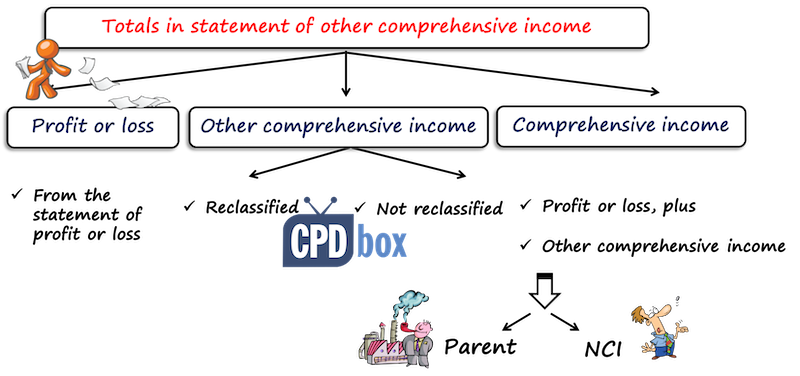
Similarly as with profit or loss, an entity should present comprehensive income for the period in allocation:
- attributable to non-controlling interests and
- attributable to owners of the parent.
5. Statement of financial position
IFRS 18 does not change much about the presentation of the statement of financial position (balance sheet) in comparison with IAS 1.
IFRS 18 requires presentation of classified statement of financial position where current assets or liabilities are separated from non-current assets or liabilities.
With regard to a minimum content, the following line items shall be presented:
| ASSETS | EQUITY AND LIABILITIES |
|---|---|
| Property, plant and equipment | Issued capital and reserves attributable to owners of the parent |
| Investment property | |
| Intangible assets | Non-controlling interests |
| Financial assets | Financial Liabilities |
| Investments accounted for using equity method | Provisions |
| Biological assets | |
| Inventories | |
| Trade and other receivables | Trade and other payables |
| Cash and cash equivalents | |
| Totals of assets in accordance with IFRS 5 Non-current assets Held for Sale and Discontinued Operations | Totals of liabilities in accordance with IFRS 5 Non-current assets Held for Sale and Discontinued Operations |
| Current tax assets | Current tax liabilities |
| Deferred tax assets | Deferred tax liabilities |
Further subclassifications of the line items shall be disclosed either directly in the statement of financial position or in the notes, such as disaggregation of property, plant and equipment into classes, and similar.
Also, certain information related to the share capital, reserves and a few others shall be included in the statement of financial position, the statement of changes in equity or in the notes.
IFRS 18 does NOT prescribe the precise format of the statement of financial position. Instead, several formats are acceptable if they fulfill all requirements outlined above.
6. Statement of changes in equity
The requirements for statement of changes in equity in IFRS 18 are carried over from IAS 1, so they remain unchanged.
As a minimum, the statement of changes in equity must contain the following items:
- total comprehensive income for the period, showing separately amounts attributable to owners of the parent and to non-controlling interests
- the effect of retrospective application or restatement for each component of equity (if applicable)
- the reconciliation between the carrying amount at the beginning and the end of the period for each
component of equity. Here, the following changes shall be disclosed separately:- those resulting from profit or loss
- resulting from other comprehensive income
- resulting from transactions with owners (contributions, distributions and changes in ownership)
For the practical example showing the preparation of the statement of changes in equity step by step, please see this article with the video and excel file.
Also, IFRS 18 prescribes to present amount of dividends recognized as distributions and the related amount per share on the face of the statement of changes in equity or in the notes.
7. Notes to the Financial Statements
The notes are meant to be the document accompanying numerical financial statements listed above. They should provide additional information not contained in the numbers, the basis of preparation of the financial statements and some additional information that might be relevant.
IFRS 18 sets that the notes shall contain at least:
- information about the basis for preparation of the financial statements;
- accounting policies used;
- information required by IFRS that is not presented in the primary financial statements – those are all subtotals and additional disclosures as required by other standards;
- other information that is not presented in the primary financial statements – for example, information about significant events or trends or contracts that might affect the business;
.
The notes shall be prepared in the systematic manner and be cross-referenced to the financial statements.
The new requirement in IFRS 18 is the presentation of management-defined performance measures.
You can read more about the notes and how to write them in this article.
8. Final word and video
IFRS 18 contains much more extensive guidance in its appendices than the older IAS 1 and due to new classification of income and expenses, it might require some time to prepare.
Here’s the video with the summary of IFRS 18:
JOIN OUR FREE NEWSLETTER AND GET
report "Top 7 IFRS Mistakes" + free IFRS mini-course
Please check your inbox to confirm your subscription.
10 Comments
Leave a Reply Cancel reply
Recent Comments
- Anguyo Sam on Can you capitalize it as PPE or not?
- Saide Ali on IFRS Sustainability Reporting Just Behind Your Door
- Agustus Arel Gon on IAS 8 Accounting Policies, Changes in Accounting Estimates, Errors
- Silvia on IAS 36 Explained (2025): Full Impairment Guide + Free Practical Checklist
- Junaid Alam Khan on IAS 36 Explained (2025): Full Impairment Guide + Free Practical Checklist
Categories
- Accounting Policies and Estimates (14) 14
- Consolidation and Groups (25) 25
- Current Assets (21) 21
- Financial Instruments (56) 56
- Financial Statements (54) 54
- Foreign Currency (9) 9
- IFRS Videos (73) 73
- Insurance (3) 3
- Most popular (6) 6
- Non-current Assets (55) 55
- Other Topics (15) 15
- Provisions and Other Liabilities (46) 46
- Revenue Recognition (26) 26
- Uncategorized (1) 1

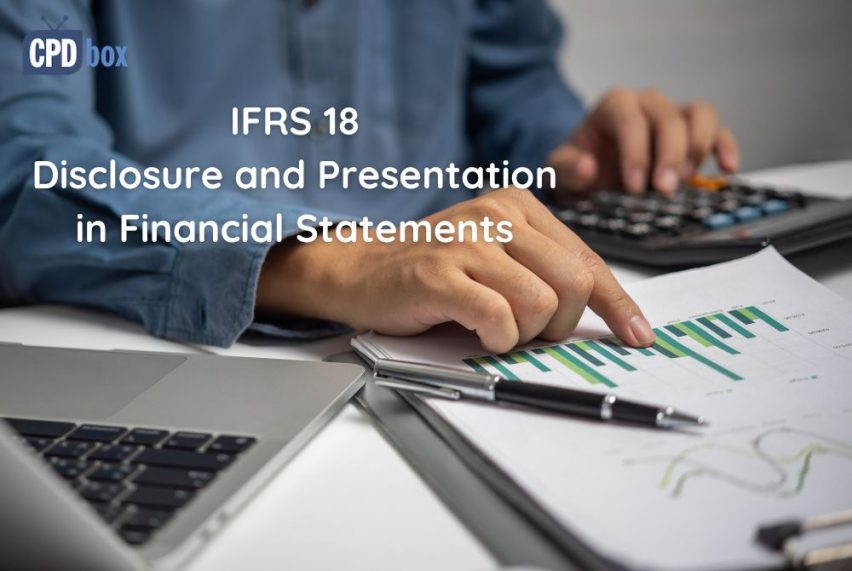


The income and expenses from cash and cash equivalents that should be included in the investing category. Would that include the monthly bank charges / admin fees levied on these accounts? Or does it only relate to the interest income/expense on the cash and cash equivalents?
Just to mention you are amazing! Thank you.
Can explain more on presentation of management-defined performance measures? Is it have to disclose as new para on the “Notes of Financial Statement”?
That’s planned, too
Where should be FX gains/losses reported according to IFRS 18? In operating part (if they are related to operations)?
Yes, together with the underlying transaction.
Where exactly would you show this? In the same line item as the underlying transaction? Or in a seperate line item “FX losses from operating activities”?
IFRS 18 does not say precisely, so it really boils down to the general rules of materiality, aggregation and disaggregation. If those FX losses/gains represent indeed material item, then maybe it would be appropriate to show them separately, otherwise together with the underlying transaction.
Can you supply us a format of income statement according to IFRS 18
I will publish some examples soon, but there is no prescribed format.